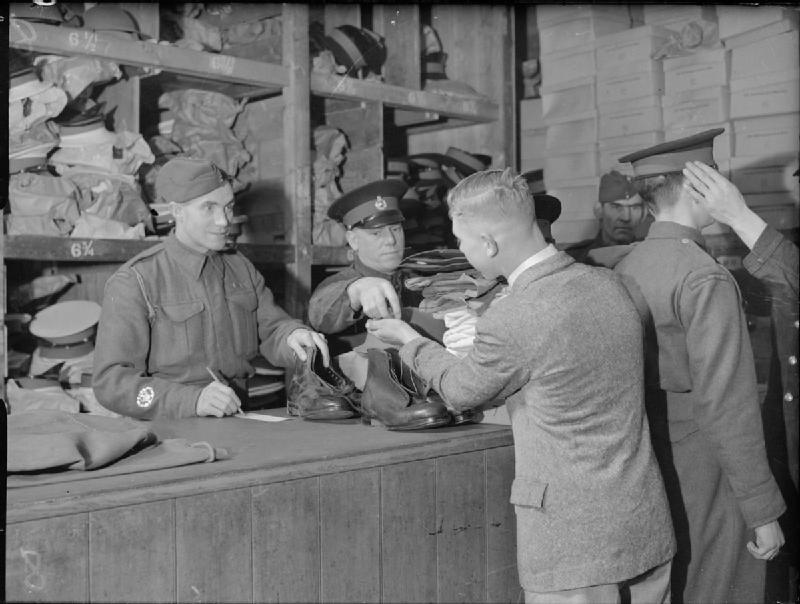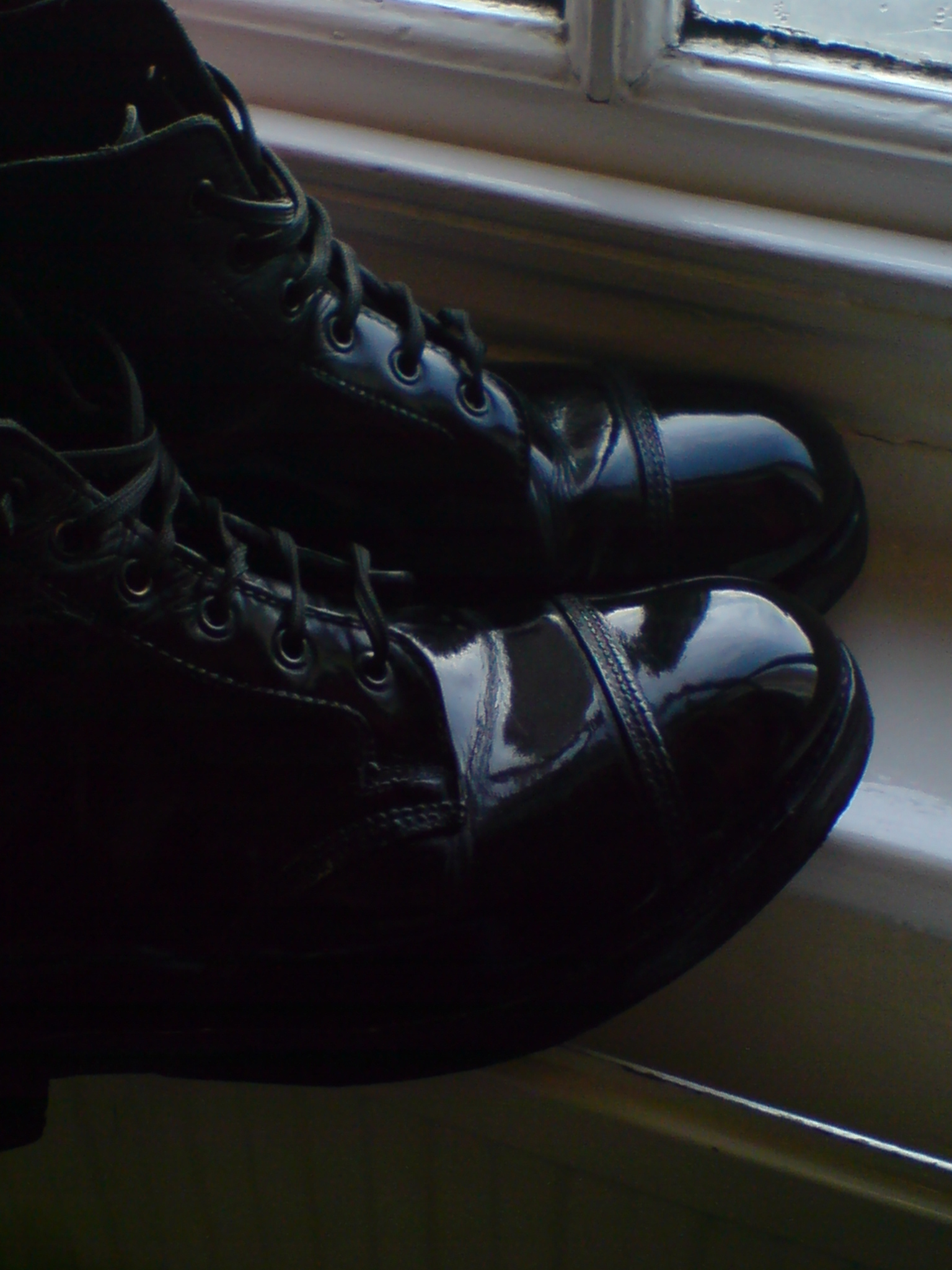Ammunition boot on:
[Wikipedia]
[Google]
[Amazon]
 Ammunition boots are a form of military
Ammunition boots are a form of military
 Ammunition boots were unlined ankle- boots, usually with leather laces, iron heel-plate and toe-plate, and an iron-studded leather sole. The vamp (front) and quarters (sides) were often made of a contrasting type of leather than the toe case (toe cap) and counter (heel cap), one made of "pebble-grained" (dimpled) leather and the other of smooth leather. They were designed to be hard-wearing and long-lasting rather than comfortable. The
Ammunition boots were unlined ankle- boots, usually with leather laces, iron heel-plate and toe-plate, and an iron-studded leather sole. The vamp (front) and quarters (sides) were often made of a contrasting type of leather than the toe case (toe cap) and counter (heel cap), one made of "pebble-grained" (dimpled) leather and the other of smooth leather. They were designed to be hard-wearing and long-lasting rather than comfortable. The
 The boots were the focus of much drill and attention. Achieving a high polish was often the aim and required hours of "bulling" (vigorous polishing) until it achieved a mirror like shine. Experienced soldiers would "burn-down" the dimpled surface of the boots with
The boots were the focus of much drill and attention. Achieving a high polish was often the aim and required hours of "bulling" (vigorous polishing) until it achieved a mirror like shine. Experienced soldiers would "burn-down" the dimpled surface of the boots with
Army Boots - British
{{DEFAULTSORT:Ammunition Boot 1880s fashion 19th-century fashion 20th-century fashion British Army equipment British military uniforms Military boots
 Ammunition boots are a form of military
Ammunition boots are a form of military footwear
Footwear refers to garments worn on the feet, which typically serve the purpose of protective clothing, protection against adversities of the environment such as wear from rough ground; stability on slippery ground; and temperature.
*Shoes and si ...
. They were the standard combat boot
Combat or tactical boots are military boots designed to be worn by soldiers during combat or combat training, as opposed to during parades and other ceremonial duties. Modern combat boots are designed to provide a combination of grip, ankle ...
for the British Army
The British Army is the principal Army, land warfare force of the United Kingdom. the British Army comprises 73,847 regular full-time personnel, 4,127 Brigade of Gurkhas, Gurkhas, 25,742 Army Reserve (United Kingdom), volunteer reserve perso ...
and other forces around the British Empire
The British Empire comprised the dominions, Crown colony, colonies, protectorates, League of Nations mandate, mandates, and other Dependent territory, territories ruled or administered by the United Kingdom and its predecessor states. It bega ...
and Commonwealth from at least the mid-1860s until their replacement a century later in the 1960s with the rubber-soled Boots DMS (for 'Direct Moulded Sole').
They replaced the earlier ankle boots that had been in service since the early 1800s. Ammunition boots (now known as Boots, Ankle, General Service) remain in use today by British and Commonwealth armies for ceremonial public duties
Public duties are performed by military personnel, and usually have a ceremonial or historic significance rather than an overtly operational role.
Armenia
Since September 2018, the Honour Guard Battalion (Armenia), Honour Guard Battalion of the Mi ...
, most notably by the British Army's Household Division, who provide the King's Guard.
The term "Ammunition boots" is a generic term for these heavy, studded ankle boots, which were produced in a variety of patterns. The name supposedly comes from the boots' being historically procured by the Master Gunner and the Munitions Board at Woolwich (the Regiment of Artillery's headquarters) rather than Horse Guards (the headquarters of the British Army), and being of 'ammunition quality'.
History
 Ammunition boots were unlined ankle- boots, usually with leather laces, iron heel-plate and toe-plate, and an iron-studded leather sole. The vamp (front) and quarters (sides) were often made of a contrasting type of leather than the toe case (toe cap) and counter (heel cap), one made of "pebble-grained" (dimpled) leather and the other of smooth leather. They were designed to be hard-wearing and long-lasting rather than comfortable. The
Ammunition boots were unlined ankle- boots, usually with leather laces, iron heel-plate and toe-plate, and an iron-studded leather sole. The vamp (front) and quarters (sides) were often made of a contrasting type of leather than the toe case (toe cap) and counter (heel cap), one made of "pebble-grained" (dimpled) leather and the other of smooth leather. They were designed to be hard-wearing and long-lasting rather than comfortable. The hobnail
In footwear, a hobnail is a short nail with a thick head used to increase the durability of boot Sole (shoe), soles or provide traction.
History
Hobnailed boots (in Scotland "tackety boots") are boots with hobnails (nails inserted into the ...
-studded soles made a loud crunching sound when the wearer was marching, earning them the nickname "crunchies".
Prior to the First World War, British soldiers were issued two pairs of boots, both made with a brown finish that had to be polished black. There was a brief period (1908 to 1914) where they were issued one pair that was hand-polished in black for parade and drill, and one pair finished in raw brown hide for fatigue duty and field service. World War I
World War I or the First World War (28 July 1914 – 11 November 1918), also known as the Great War, was a World war, global conflict between two coalitions: the Allies of World War I, Allies (or Entente) and the Central Powers. Fighting to ...
forced the reversion to brown leather boots for Other Ranks, and a simplification of the patterns, but polished black boots were still worn by some individuals or units out of habit. Officers, who purchased their own uniforms, were still required to wear polished brown boots and matching leather Sam Browne belt with their field service uniform, marking them apart from their men. Officers' boots had heel plates, but lacked the sole studs and toe plates because they could afford to have the soles replaced. The later Boots, General Service adopted in 1927 were issued from the factory in black leather.
Patterns
The original Pattern 1037 was made from 1887 to 1907. During theSecond Boer War
The Second Boer War (, , 11 October 189931 May 1902), also known as the Boer War, Transvaal War, Anglo–Boer War, or South African War, was a conflict fought between the British Empire and the two Boer republics (the South African Republic and ...
(1899–1902), civilian manufacturers made a series of variants on the Pattern 1037 due to differing manufacturing techniques (like machine-sewn uppers or glued-on outer soles).An improved 1037i pattern was adopted from 1907 to 1911. It was temporarily replaced by the similar 7325 and 7326 patterns from 1911 to 1914 while they did research for a replacement boot. The experimental "A" and "HN" series were also made during this time but were obsolete by the dawn of World War I.
By 1915, the "B" series was begun, consisting chiefly of the "B2" and "B5". It was a pattern of ammunition boot with woven cotton laces, a plain-leather counter, and lacked the leather toe cap. It was created to save leather and increase production. To reinforce the boot and increase wear the B2 series had a horizontal seam between the parts of the upper and the "B5" series had rivets between the vamp and quarters.
In 1918, the post-war 9902 pattern came into service. It had a "clump sole" (one-piece sole and heel), smooth leather vamp and quarters, and pebbled-leather counter and toe-cap. It came in brown leather, but was polished black.
In 1924, the Pattern 4055 boot, forerunner of the ''Boot, General Service'' (BGS) was issued. It came in brown leather and had 25 hobnails. In 1927, the later Pattern 10085 boot, the BGS, was similar except it came in black leather.
Variant patterns
Vehicle drivers wore boots withouthobnail
In footwear, a hobnail is a short nail with a thick head used to increase the durability of boot Sole (shoe), soles or provide traction.
History
Hobnailed boots (in Scotland "tackety boots") are boots with hobnails (nails inserted into the ...
s because they would damage the pedals and create sparks. This was extended to armoured vehicle crews in the Royal Tank Regiment and Reconnaissance Corps in 1942, as well as to the crews of waterborne craft of the Royal Army Service Corps in 1943.
Specialists and ammunition storemen were issued regular ammunition boots with rubber heels and rubber crepe soles that lacked the hobnails and steel heel- and toe-plates. This was to avoid creating sparks near flammable or explosive stores (like gunpowder or gasoline). Commandos were issued them to make it easier for them to move silently.
During World War II
World War II or the Second World War (1 September 1939 – 2 September 1945) was a World war, global conflict between two coalitions: the Allies of World War II, Allies and the Axis powers. World War II by country, Nearly all of the wo ...
, a pattern without the toecap was used by the Canadian Army
The Canadian Army () is the command (military formation), command responsible for the operational readiness of the conventional ground forces of the Canadian Armed Forces. It maintains regular forces units at bases across Canada, and is also re ...
and was issued to the Royal Air Force
The Royal Air Force (RAF) is the Air force, air and space force of the United Kingdom, British Overseas Territories and Crown Dependencies. It was formed towards the end of the World War I, First World War on 1 April 1918, on the merger of t ...
and the Royal Marines
The Royal Marines provide the United Kingdom's amphibious warfare, amphibious special operations capable commando force, one of the :Fighting Arms of the Royal Navy, five fighting arms of the Royal Navy, a Company (military unit), company str ...
. As an economy measure the number of hobnails were reduced in April, 1942 to 15 hobnails, later reduced to 13 hobnails in September, 1942.
beeswax
Bee hive wax complex
Beeswax (also known as cera alba) is a natural wax produced by honey bees of the genus ''Apis''. The wax is formed into scales by eight wax-producing glands in the abdominal segments of worker bees, which discard it in o ...
and a heated spoon to make them smooth and easier to shine.
See also
* List of shoe stylesNotes
References
Army Boots - British
{{DEFAULTSORT:Ammunition Boot 1880s fashion 19th-century fashion 20th-century fashion British Army equipment British military uniforms Military boots